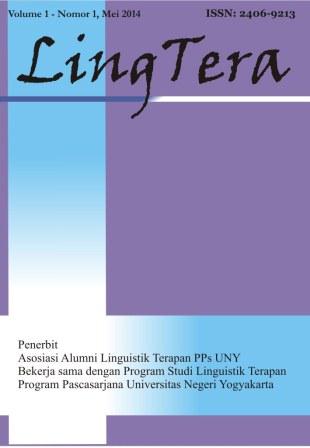Examining lexical density of Bahasa Indonesia for foreign language learners (BIPA) textbook
DOI:
https://doi.org/10.21831/lt.v11i1.67363Keywords:
Lexical density, textbook, Bahasa Indonesia for foreign language learner, BIPAAbstract
References
Amer, M. A. B. (2021). Lexical density and readability of secondary stage English textbooks in Jordan. International Journal for Management and Modern Education. 2, (2) 11-20
Aziz, E. A. (2023, February 23). Bahasa daerah dalam impitan zaman. Badan Pengembangan dan Pembinaan Bahasa - Kemendikbudristek. Badan Pengembangan dan Pembinaan Bahasa. https://badanbahasa.kemdikbud.go.id/artikel-detail/3848/bahasa-daerah-dalam-impitan-zaman
Bukoye, R. O. (2018, June 20–22). Utilization of instruction materials as tools for effective academic performance of students: Implications for counselling. The 2nd Innovative and Creative Education and Teaching International Conference (Icetic2018), Badajoz, Spain.
Castello, E. (2008). Text complexity and reading comprehension tests. Peter Lang.
Daller, H., van Hout, R., & Treffers-Daller, J. (2003). Lexical richness in the spontaneous speech of bilinguals. Applied Linguistics, 24(2), 197-222.
Fajardo, I., ívila, V., Ferrer, A., Tavares, G., Gómez, M., & Hernández, A. (2014). Easy"to"read texts for students with intellectual disability: linguistic factors affecting comprehension. Journal of Applied Research in Intellectual Disabilities, 27(3), 212-225.
Gregori-Signes, C., & Clavel-Arroitia, B. (2015). Analysing lexical density and lexical diversity in university students' written discourse. Procedia - Social and Behavioral Sciences, 198, 546–556. doi:10.1016/j.sbspro.2015.07.477
Halliday, M. A. K. (1985). Spoken and written language. [Waurn Ponds], Vic: Deakin University.
Halliday, M. A. K., & Matthiessen. (2004). An introduction to functional grammar (3rd Eds.). Edward Arnold.
Ismail, N. M., Yoestara, M., & Jamilah, S. (2023). Comparing lexical density in teacher talks: Elementary school and higher education level. LLT Journal: A Journal on Language and Language Teaching, 26(1), 142-152.
Johansson, V. (2008). Lexical diversity and lexical density in speech and writing: A developmental perspective. Lund University, Dept. of Linguistics and Phonetics Working Papers, 53, 61-79.
Krashen, S. (2002). Theory versus practice in language training. In Enriching ESOL pedagogy (pp. 235-252). Routledge.
Kementerian Pendidikan dan Kebudayaan. (2018). Bahasa dan peta bahasa di Indonesia (pp. 12–13).
Kurniawan, K., Fahmi, R. N., & Mulyaningsih, I. (2022). Kesesuaian isi buku ajar BIPA "Sahabatku Indonesia" untuk penutur bahasa Inggris level 1 (Conformity of BIPA textbook contents "Sahabatku Indonesia" for level 1 English speakers). Indonesian Language Education and Literature, 7(2), 279-293.
Laufer, B. (2005). Lexical frequency profiles: From Monte Carlo to the real world. A response to Meara (2005). Applied Linguistics, 26(4):582-588.
Maamuujav, U. (2021). Examining lexical features and academic vocabulary use in adolescent L2 students' text-based analytical essays. Assessing Writing, 49, 100540.
Masyi'ah, A. N., & Ciptaningrum, D. S. (2018). An analysis and evaluation of two English textbooks for second graders of junior high school. LingTera, 5(1), 32-40.
Marlin, S., & Ashadi, A. (2019). Examining English textbook prototype development for vocational high school students. LingTera, 6(2), 162-171.
Mulyanti, W., & Soeharto, P. P. (2020, April). Text complexity in English textbooks for junior high school: A systemic functional perspective. In Twelfth Conference on Applied Linguistics (CONAPLIN 2019) (pp. 217-222). Atlantis Press.
Nasseri, M., & Thompson, P. (2021). Lexical density and diversity in dissertation abstracts: Revisiting English L1 vs. L2 text differences. Assessing Writing, 47, 100511.
Perfetti, C. A. (1969). Lexical density and phrase structure depth as variables in sentence retention. Journal of Verbal Learning and Verbal Behavior, 8(6), 719–724. doi:10.1016/s0022-5371(69)80035-6
Pinto, M., Caballero, D., Sales, D., & Segura, A. (2020). Belief in importance of information literacy abilities among undergraduates. Underlying factors and analysis of variance. Reference Services Review, 48(4), 559–577. doi:10.1108/rsr-03-2020-0020
Putra, D. A., & Lukmana, I. (2017). Text complexity in senior high school English textbooks: A systemic functional perspective. Indonesian Journal of Applied Linguistics, 7(2), 436-444.
Rizkiani, D., Mahdi, S., & Sujatna, E. T. S. (2022). Lexical density and readability of the Facil's "˜advanced learning textbook'for Indonesian high school students. AL-ISHLAH: Jurnal Pendidikan, 14(1), 741-752.
Sari, D. (2016). Measuring quality of reading materials in English textbook: The use of lexical density method in assessing complexity of reading materials of Indonesia's curriculum–13 (K13) English textbook Dian Sari. JOALL (Journal of Applied Linguistics and Literature), 1(2), 30-39.
Solikhah, I., & Budiharso, T. (2020). Standardizing BIPA as an international program of a language policy. Asian ESP Journal, 16(5.2), 181-205.
Stromqvist, S., Victoria, J., Sarah, K., Hrafnhildur, R.,Ravid, A., & Dorit R. (2002). 'Toward a crosslinguisticcomparison of lexical quanta in speech and writing'. Written language and literacy, 5,45-67
Sujatna, E. T. S., Heriyanto, H., & Andri, S. (2021). Lexical density and variation in Indonesian folklores in English student textbooks: An SFL study. Leksika: Jurnal Bahasa, Sastra dan Pengajarannya, 15(2), 62-67.
Suyitno, I. (2007). Pengembangan bahan ajar Bahasa Indonesia untuk Penutur Asing (BIPA) berdasarkan hasil analisis kebutuhan belajar. Wacana, 9 (1), 62–78.
Syarif, H., & Putri, R. E. (2018). How lexical density reveals students'ability in writing academic text. Lingua Didaktika: Jurnal Bahasa dan Pembelajaran Bahasa, 12(2), 86-94. https://doi.org/10.24036/ld.v12i1.10408
To, V., Fan, S., & Thomas, D. (2013). Lexical density and readability: A case study of English textbooks. Internet Journal of Language, Culture and Society, 37(37), 61-71.
Ure, J. (1971). Lexical density and register differentiation. In G. Perren and J.L.M.Trim (eds), Applications of Linguistics. Cambridge University Press.
Zamanian, M., & Heydari, P. (2012). Readability of texts: State of the art. Theory & Practice in Language Studies, 2(1).
Downloads
Published
How to Cite
Issue
Section
Citation Check
License
LingTera allows readers to read, download, copy, distribute, print, search, or link to its articles' full texts and allows readers to use them for any other lawful purpose. The journal allows the author(s) to hold the copyright without restrictions. Finally, the journal allows the author(s) to retain publishing rights without restrictions.
- Authors are allowed to archive their submitted articles in an open-access repository.
- Authors are allowed to archive the final published article in an open-access repository with an acknowledgment of its initial publication in this journal.

Psychology, Evaluation, and Technology in Educational Research is licensed under a Creative Commons Attribution-ShareAlike 4.0 International License.
Based on a work at https://petier.org/index.php/PETIER.









